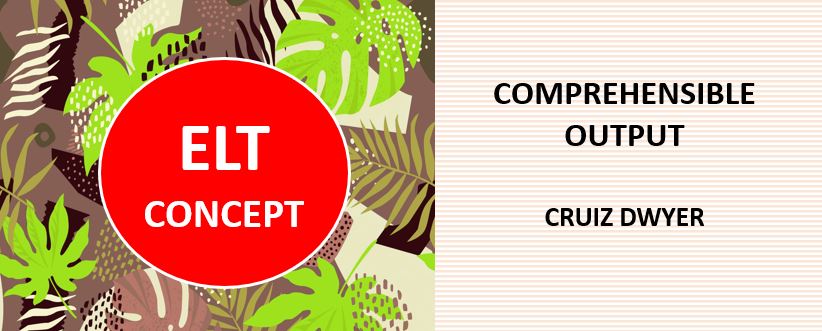ELT Concept #9 – Comprehensible Output
Cruiz Dwyer
What is it?
Comprehensible Output is a language acquisition theory developed by Merill Swain. It states that although students need to receive a lot of comprehensible input, this is not enough. They also need to produce comprehensible output, i.e., using language that is understood by other people.
The theory claims that to develop language ability, students need to become aware of gaps in their knowledge. Speaking or writing provides students with ample opportunities to notice these gaps. For example, when communicating with other people, they find that people often have difficulty understanding their utterances. When this happens, they often need to correct themselves, revise their earlier sentences that were not clear and rephrase their ideas to make them more comprehensible. This process, according to Swain, helps students consolidate their knowledge and enables them to further develop their language competence.
Why is it important?
Language acquisition occurs in 3 stages: input, interaction, and output. Output is the most noticeable indicator that a learner has internalized what they have learnt. Additionally, input alone is not the only means to developing language knowledge. If it were, this would suggest a very linear means by which all language, and knowledge in general, could be learnt.
Swain believes that being conscious of what you do not know allows you to proceed into a new form of input. This input is more effective than being taught. Language is a social act, one in which the participants engage in a dialogic relationship. Any mistake someone makes can be instantly spotted, allowing the speaker to instantly correct themselves. And this is what allows you to learn to be comprehensible.
My Reflection
During my time teaching, I have taught students of many skill levels. And I feel that an overemphasis on output can be limiting. The Comprehensible Output hypothesis requires students to have absolute focus when producing language. Yet, many forms of communication are casual in nature. Additionally, the hypothesis may not apply to low-proficiency students, who are in an early learning phase.
Speaking, and especially writing, are not easy skills for students with little-to-no knowledge of a new language. With limited knowledge, how would they be able to even create any form of output that would be meaningful? Students will need an incredible amount of input in the early stages of their learning. Their ability to produce intelligible language will still be at a very early stage of development.
When students have acquired some language and reached a certain level of proficiency, then looking at the output as a means for language growth becomes viable. However, students still need to be aware that mistakes are taking place. Constant awareness of the language they are using is important, but also unrealistic. This is another skill that students need to acquire to truly make use of their internal ability to correct themselves.
That said, once a student has received the necessary instruction to produce their L2 on a regular basis, then output can start to become a dominant form of language acquisition. Comprehensible Output is a model that can be used to enhance the learning journey for students. But it is only one step along their journey and not a starting point.
ELT Concept #8 – Genre Model


One Reply to “Comprehensible Output”